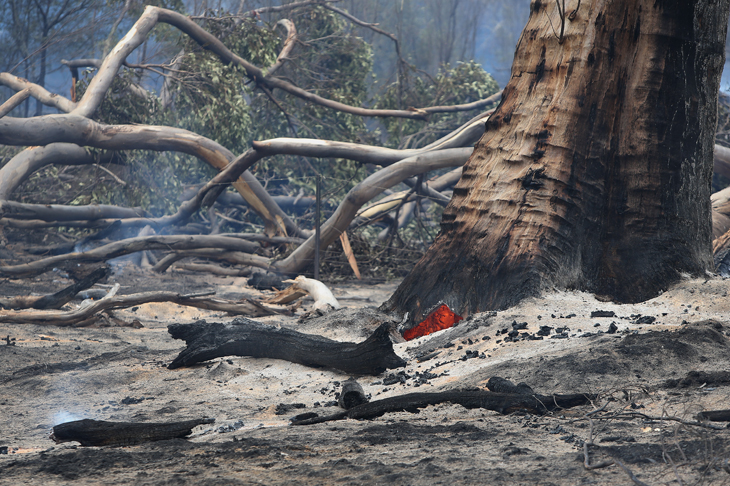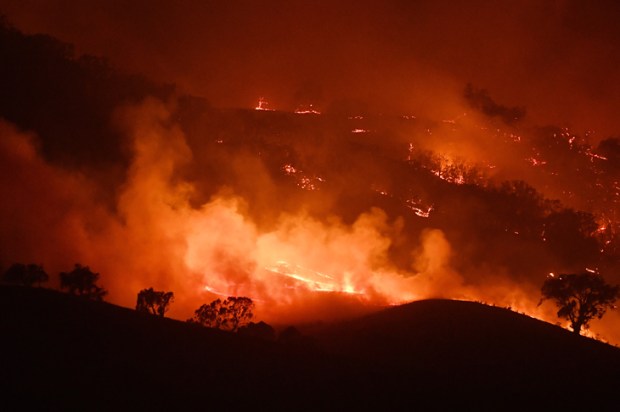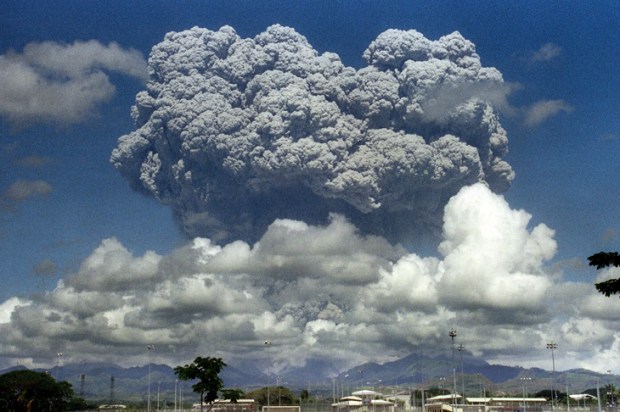Have you noticed how chaotic and wasteful eucalypts are? They have branches that grow in all directions and lengths and they seem to be forever dropping dead bits off them. Why hasn’t natural selection tidied them up so their branches are all economically organised to maximise access to light like beautifully ordered pines or symmetrical oaks? A eucalyptus tree actually looks like a whole lot of trees fighting with each other for access to the light. In fact, a trick to painting a eucalypt is to simply place a lot of grey-green blobs near each other and then connect them with stalks to a central trunk, and voilà, you have a eucalypt.
What this chaotic structure suggests to me as a biologist is that eucalypts are an ‘upstart species’—a species that has hit upon some novel, beats-all strategy that has allowed them to develop and proliferate at such a rapid rate that natural selection hasn’t had time to refine the design of their new opportunity.
Fossil evidence suggests that eucalypts originally emerged from our Australian rainforests and then quickly spread and conquered virtually the whole of Australia, with botanists recognising that every variety of plant community in Australia, be it heathland, scrub, open woodland or forest, is dominated by a variety of eucalypt, the only exception being the very dry inland that is still dominated by acacias.
So what could this magic strategy that eucalypts have hit upon be? Well, eucalypts happen to have epicormic buds, buds hidden in the sapwood under their bark that are protected from fire and so can quickly sprout afterwards, which you can see when you drive through a eucalypt forest some months after a bushfire—the charred trunks are covered with lush sprouting shoots.
Basically, eucalypts can survive an intense fire when few other species can; and since they can survive fire they can afford to encourage fire because it will eliminate competition from other species.
In fact, natural selection has seemingly led to eucalypts actively cultivating fire because they now have very waxy, oily flammable leaves, which they are constantly shedding to accumulate beds of fire-fuelling litter at their base, and peeling bark that flies through the air as lit tapers to start new fires many kilometres ahead. The Blue Mountains west of Sydney are so-named because the oil in the eucalypts along the mountain range is constantly evaporating and creating a blue haze.
Eucalypts are essentially fire-fuelling incinerators that generate so much heat when they catch fire that when one burns its radiant heat evaporates the oils in the neighbouring eucalypts creating a flammable gas which ignites as a fireball, and so the crowns of the trees explode with fire one after the other, triggering a ‘crown fire’—a wave of exploding eucalypt canopies that race through the Australian bush like a tornado.
No wonder they are referred to as ‘gasoline trees’.
David Bowman, a forest ecologist at the University of Tasmania, was describing the novel strategy of eucalypts when he said, ‘Give a hillside a really good torching and the eucalyptus will absolutely dominate. They’ll grow intensively in the first few years of life and outcompete everything’ (‘Australia’s wildfires: Are Eucalyptus Trees to Blame?’, Live Science, 21 Oct. 2013).
This ‘trick’ of being extremely fire-adapted obviously requires fire, which lightning can cause. But to be the ‘upstart’ and ‘still-chaotically-designed’ species that they are would suggest eucalypts have benefited from a relatively recent occurrence of much more fire than lightning strikes could account for.
That provider of regular fire would seem to be the arrival of Aborigines some 40-60,000 years ago. As Viv Forbes wrote in his recent article in the Australian: ‘Fires lit by Aboriginal men and women created the landscape of Australia. They used fire to create and fertilise fresh new grass for the grazing animals they hunted… Their fires created and maintained grasslands and open forest… Aboriginal fire ‘management’ worked brilliantly. Because of the high frequency of small fires, fire intensity was low and fires could be lit safely even in summer’ (‘Revive ancient skills to better manage bushfires’, 31 Dec., 2019). Evidence that the fire-adapted eucalypts spread in parallel with the arrival and spread of Aborigines is supported by an article on the history of Australian flora which said that ‘the gums are… all but absent until a few tens of thousands of years ago’ (review of Ashley Hay’s 2002 book ‘Gum’, the Bulletin magazine, 19 Nov., 2002). If fires from lightning strikes had been numerous enough to allow for the proliferation of eucalypts and the development of our current fire-weed, gum-tree monoculture then surely it would have appeared much earlier in the fossil record.
This extraordinary affinity with fire means eucalypts have to be viewed as extremely dangerous incinerators that must be kept away from residential and commercial zones. They are not like other trees that we can surround ourselves with because of their natural beauty or shade qualities. Rather (and greenies especially should note this) we have to view eucalypts as being like dangerous crocodiles planted tail-down ready to destroy lives and our world—including so much of our wildlife with estimates of over a billion animals having been killed by this summer’s fires. Fires in non-eucalypt forests are bad enough, but eucalypt forest fires are so frequent, ferocious and destructive that eucalypt forests actually represent a lost part of our continent. Humans can’t live near them, and they are an extremely dangerous habitat for wildlife.
Basically, there has to be a complete change of mindset when thinking about eucalypts that recognises their true nature. The stark reality is there should be legislation in Australia preventing eucalypts from growing in quantity near people. We also need to enforce regular hazard reduction burns in eucalypt forests, otherwise the incineration of the whole east coast of Australia that we’re experiencing will keep occurring, especially in times of extreme drought.
Eucalypts were planted overseas with gusto because they’re fast growing and have hard wood but the world is starting to wake up to this ‘crocodile’ in their midst; as David Bowman also said, ‘What the hell have humans done? We’ve spread a dangerous plant all over the world.’
Jeremy Griffith is an Australian biologist based in Sydney, and the founder of the non-profit World Transformation Movement at www.HumanCondition.com.
Got something to add? Join the discussion and comment below.
Get 10 issues for just $10
Subscribe to The Spectator Australia today for the next 10 magazine issues, plus full online access, for just $10.
You might disagree with half of it, but you’ll enjoy reading all of it. Try your first month for free, then just $2 a week for the remainder of your first year.














Comments
Don't miss out
Join the conversation with other Spectator Australia readers. Subscribe to leave a comment.
SUBSCRIBEAlready a subscriber? Log in